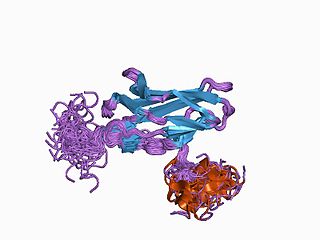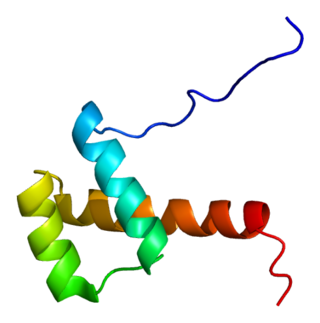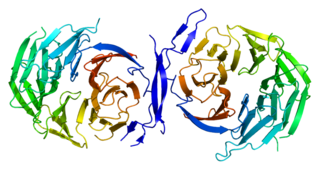Transducin-like enhancer protein 1 is a protein that in humans is encoded by the TLE1 gene. [5] [6] [7]
Transducin-like enhancer protein 1 is a protein that in humans is encoded by the TLE1 gene. [5] [6] [7]
TLE1 has been shown to interact with:

Histone deacetylase 1 (HDAC1) is an enzyme that in humans is encoded by the HDAC1 gene.

The nuclear receptor co-repressor 2 (NCOR2) is a transcriptional coregulatory protein that contains several nuclear receptor-interacting domains. In addition, NCOR2 appears to recruit histone deacetylases to DNA promoter regions. Hence NCOR2 assists nuclear receptors in the down regulation of target gene expression. NCOR2 is also referred to as a silencing mediator for retinoid or thyroid-hormone receptors (SMRT) or T3 receptor-associating cofactor 1 (TRAC-1).

Runt-related transcription factor 1 (RUNX1) also known as acute myeloid leukemia 1 protein (AML1) or core-binding factor subunit alpha-2 (CBFA2) is a protein that in humans is encoded by the RUNX1 gene.

Paired amphipathic helix protein Sin3a is a protein that in humans is encoded by the SIN3A gene.

Lymphoid enhancer-binding factor 1 (LEF1) is a protein that in humans is encoded by the LEF1 gene. It is a member of T cell factor/lymphoid enhancer factor (TCF/LEF) family.

Runt-related transcription factor 3 is a protein that in humans is encoded by the RUNX3 gene.

C-terminal-binding protein 1 also known as CtBP1 is a protein that in humans is encoded by the CTBP1 gene. CtBP1 is one of two CtBP proteins, the other protein being CtBP2.

Transcription factor HES1 is a protein that is encoded by the Hes1 gene, and is the mammalian homolog of the hairy gene in Drosophila. HES1 is one of the seven members of the Hes gene family (HES1-7). Hes genes code nuclear proteins that suppress transcription.

Hematopoietically-expressed homeobox protein HHEX is a protein that in humans is encoded by the HHEX gene and also known as Proline Rich Homeodomain protein PRH.

Dr1-associated corepressor is a protein that in humans is encoded by the DRAP1 gene.

Msx2-interacting protein is a protein that in humans is encoded by the SPEN gene.

Homeobox protein SIX3 is a protein that in humans is encoded by the SIX3 gene.

Transducin-like enhancer protein 2 is a protein that in humans is encoded by the TLE2 gene.

Transducin-like enhancer protein 3 is a protein that in humans is encoded by the TLE3 gene.

Transcription cofactor HES-6 is a protein that in humans is encoded by the HES6 gene.

Histone demethylase UTY is an enzyme that in humans is encoded by the UTY gene.

Histone deacetylase complex subunit SAP18 is an enzyme that in humans is encoded by the SAP18 gene.

Transducin-like enhancer protein 4 is a protein that in humans is encoded by the TLE4 gene.

PHD finger protein 12 is a protein that in humans is encoded by the PHF12 gene.

(HES7) or bHLHb37 is protein coding mammalian gene found on chromosome 17 in humans. HES7 is a member of the Hairy and Enhancer of Split families of Basic helix-loop-helix proteins. The gene product is a transcription factor and is expressed cyclically in the presomitic mesoderm as part of the Notch signalling pathway. HES7 is involved in the segmentation of somites from the presomitic mesoderm in vertebrates. The HES7 gene is self-regulated by a negative feedback loop in which the gene product can bind to its own promoter. This causes the gene to be expressed in an oscillatory manner. The HES7 protein also represses expression of Lunatic Fringe (LFNG) thereby both directly and indirectly regulating the Notch signalling pathway. Mutations in HES7 can result in deformities of the spine, ribs and heart. Spondylocostal dysostosis is a common disease caused by mutations in the HES7 gene. The inheritance pattern of Spondylocostal dysostosis is autosomal recessive.